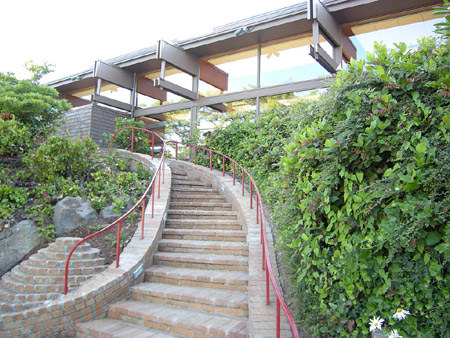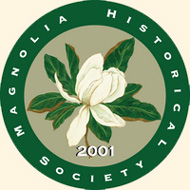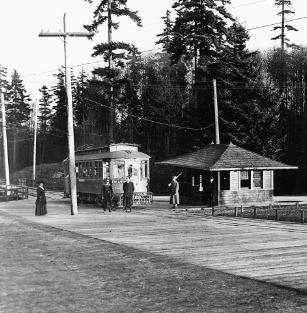By Jeffrey Cunningham
President of the Magnolia Historical Society
September 15th, 2014
How Magnolia Acquired Its Very Own Branch of the Seattle Public Library.
Then: In the 1920’s Magnolia was making the transformation from a rural community to a suburban neighborhood. During this time the Magnolia Community Council was formed and in 1932 they petitioned the city for their own branch of the library. Ballard and Queen Anne both had their own, so they felt that it was time for them as well. For Historylink.org, David Wilma wrote an excellent essay discussing the finer points of the early years of the library. He discusses how the city, to appease the residents of Magnolia, sent the Bookmobile to Magnolia Bluff. In the wake of the Great Depression and WWII rationing, the Bookmobile’s visits terminated. By 1943 the city agreed to offer a librarian part time (one each from Queen Anne and Ballard different days of the week), books and $1,500 to start a library. The Community Council contributed another $300 and the first Magnolia library opened its doors on April 1st, 1943.
In Magnolia, Making More Memories, Clinton White, a Magnolia resident, discusses how the branch got off to a “shaky start,” occupying a space converted from an abandoned tavern at 3200 West McGraw; it was only open three days a week. Indeed, the Magnolia library did move around a few times in during the 1940’s to different locations on McGraw Street, the main thoroughfare through the Village. Through the various moves, people willingly participated their time and labor to paint and physically move books. Volunteers were responsible for garbage pick up and maintenance. In 1946, Magnolia station (as it was called before it was a proper branch) received its first full time librarian, Helen Spoon. In Aleua Frare’s work, Magnolia: Yesterday and Today, she quotes a report from a librarian during the first decade of the library: “The atmosphere is different from any other branch. The whole community has a pioneer spirit, like an old country store where everyone gathers to meet their friends.” This reflects the sense of community that the library engendered within them. Magnolians had advocated for a library for sometime, and they finally were able to proudly enjoy it.
Clinton White recollects in his childhood how he would go “religiously.” Story hours on Saturdays became a very popular pastime for Magnolian children, before the days when every American home had a television; the very first one was attended by 100 people. The library maintained its popularity, in spite of the new Magnolia Theater built in 1948. Around that time there were about 4000 borrowers and 5700 titles in the library. The library did have its setbacks; in 1952, it was flooded three times, once by teenagers placing a hose in the mail slot, another from the pipes freezing and lastly by heavy rains. That same year, Elizabeth Hansmann became librarian of Magnolia station in 1952 and would not retire until 1974, long after the current building was in use.
In 1956, Seattle voters approved a bond issue for $5 million that would greatly expand and improve library services and Magnolia was finally allowed to have a permanent building for the library branch. This development took time and Magnolia residents got impatient. Many chipped in to work on a new library location in the Village in 1959; they leased an old Safeway on 34th and McGraw. Soon after, the Seattle Public Library purchased land from the Catholic Archdiocese of Seattle at 32nd and Armour for $35,000. Paul Kirk of Kirk, Wallace and McKinley Architects surveyed the site, with its shield of trees, including some of Magnolia’s characteristic madronas. He envisioned brick steps and circular patios, features that would blend in well with the natural setting. Kirk’s design is characteristically Northwest in design, with Japanese influences. The Library opened on July 17th, 1964, with Mayor Braman present. It boasted room for 12,000 adult and 10,000 children’s books.
The same year as the new library opened, residents raised funds to beautify the new space; $2500 was collected. The community funded art project testifies to the commitment people in Magnolia had for their new library. Among the items are Doves on Driftwood and Girl Holding Doves by Ebba Rapp McLaughlin, as well as Glen E. Alps’ metal sculpture. Another notable installation at the library is George Nakashima’s handcrafted walnut furniture. In 1966 the library won several architecture awards from the American Institute of Architecture, the National Book Committee, as well as the Award of Excellence from the American Library Association. Frare talks about students from the University of Washington, the University of Idaho and the University of British Columbia making trips to study the architecture. The 1970’s and 80’s were uneventful years for the library, with the exception of a few cases of vandalism and burglary. Art was stolen at various times, and in one case, it was even returned. In 1998 Seattle voters again approved a bond to renovate and restore the public library system, this time for $196.4 million. The Libraries for All Campaign, as it was called, would overhaul many of the existing library branches, including Magnolia, but most significantly the now-iconic Central Branch Downtown.
Now: The expanded Magnolia branch of the Seattle Public Library opened to a crowd on July 12, 2008. Of all of the 27 remodeled or new libraries part of the Libraries for All Campaign, Magnolia was the last to open. According the Sean Rose’s Seattle Times article the total cost of refurbishing the Magnolia branch alone was $4.4 million. The Seattle Public Library website further expounds the specifics of the renovation: it was built by Graham Construction Ltd and designed by Snyder Hartung Kane Strauss Architects. This added 1,400 square feet, which included a quiet study room, new bathrooms, as well as a large room for events and meetings, such as the Magnolia Historical Society’s writing workshops. More technology was part of the plan as well, with the addition of more computers, DVDs and CDs. Wilma’s essay mentions the accolades received by the newly restored building: in 2009, the building was awarded the Stewardship of Public Buildings award for its steadfast adherence to the original design of the building. More recognition from American Institute of Architects was also awarded in 2011. In 2012, Seattle voters approved measures that extended library services, including opening on Sundays. The new expanded Magnolia library continues to the flourish under these present conditions.




